3 reasons I ditched my life insurance as a first home buyer – finder.com.au

Why did Finder’s insurance expert drop his cover before the ink dried on his mortgage papers?
The moment I signed up to a 30-year mortgage, it dawned on me what a big debt really looks like. I could see exactly why buying a first home is a trigger for taking out life insurance. After all, it’s likely the biggest debt of your life and is one you’ll want to protect.
As an insurance writer, I’m fully aware life and income protection options go beyond your mortgage payments too. Payouts can ensure a family is able to continue to fund its lifestyle if something bad happens. In times of high living costs, insurance feels ever more important.
However, the financial advisers I speak with on a weekly basis say the same thing: individual circumstances are the basis of any personal finance decision.
With that in mind, I got rid of my cover. And here’s why I did.
Reason 1: My super balance is awful
I’ve been paying towards my retirement for only 3 years in Australia. Why? I arrived from the UK in 2019. Inevitably, my super is worryingly low for someone in their mid-thirties.
When I joined AustralianSuper, I saw I was making a monthly payment for default life cover. Okay, it was little more than a few bucks a week. But, I figured, I need to make every dollar count now to safeguard my longer-term future.
Scott Pape, AKA The Barefoot Investor, said that the time to make extra contributions to your super is “after you buy your family home”.
So, I’m looking at salary sacrificing to boost my super balance. I’ve prioritised this over life cover that will eat into my retirement savings.
Reason 2: My wife has her shit together
Like my dad, who moved to the UK from Ireland, I’m an emigrant. Unlike my dad, I’m not a bricklayer. I work a desk-based job that doesn’t require physical labour.
I also differ from my old man in that I don’t have 3 kids. I’ve never had a serious illness (yet, luckily). And, importantly, I don’t consider myself to be the main breadwinner – my Australian wife has a very solid job with the government.
My spouse and I sat down one weekend after buying our first home and took stock.
Given her strong employment situation and her stronger ties in the country, we agreed she’d keep her life cover while I’d be better off investing. For example, I’ve recently sent any spare dollars to my Finder Earn account at 4.01%.
The third reason we were able to make such a big call was that, fortunately, we were able to find a home within our means.
Reason 3: I don’t own a $1 million + house
Australia’s median property price for houses and units today is $738,975. But Domain research earlier this year found the median house price is $1.06 million across the country’s capital cities.
I said “fortunate” above because, let’s be frank, you won’t find a 4-bedroom house in the metropolitan areas of Greater Sydney, Newcastle or Wollongong priced in the 700s anymore. Well, our family home in Wollongong was.
The key difference? We got it in September 2020. There’s almost no chance we’d be part of the market with prices where they are now (even without a mention of rising interest rates).
Why you should look at direct life insurance
Homes costing north of $1 million are now par for the course in many metropolitan areas. If I was dealing with these kinds of sums for my first home, I’d be taking 2 steps immediately:
I’d review the insurance in my super. I’d want to have a strong level of life cover with TPD that covers my debt and income. Financial planner Brenton Tong told Finder: “As a general guide you want at least the total of your home mortgage and, if you have children, 5–10 times your salary.” And I’d look at income protection and trauma cover too.I’d compare brands based on their level of cover. I’d start with direct life insurers such as NobleOak and Medibank, for example, that offer maximum cover of up to $15 million and $2.5 million respectively. These are higher numbers than most providers who’ll only go as high as $1.5 million or $1 million.
The amount of life insurance you will need is a tricky question. 5 financial experts tackle this here.






